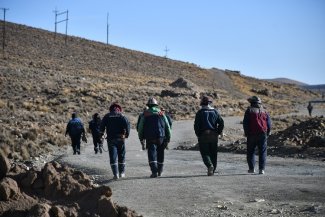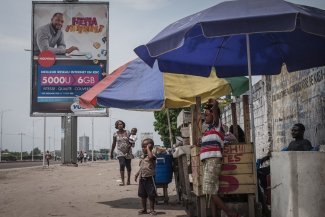If there is one global issue today that requires urgent social dialogue, it is labour migration.
The ever-increasing exploitation of undocumented and informal migrant workers amounts to what activists describe as ‘modern-day slavery’.
In Europe, the International Labour Organisation (ILO) estimates that forced labour, which is largely the result of human trafficking and irregular migration, affects as many as 880,000 people – that’s 1.8 victims per every 1,000 inhabitants.
And the numbers are increasing every year. Poverty, underdevelopment and a lack of decent work forces people to look for a better life elsewhere, at any cost.
The economic crisis has only made things worse.
According to a report on human trafficking published by the European Commission this April, over 23,000 identified or presumed trafficking victims were registered between 2008 and 2010. This represents an 18 per cent increase compared to earlier figures.
But the restrictive migration and criminal justice policies which can lead to trafficking have failed to keep pace with the labour market situation.
On the contrary, tougher border controls and deportation procedures have had the undesired consequence of making people-trafficking more profitable.
That is why we need to take the focus away from organised crime and instead look at labour market dynamics and coercive labour practices in mainstream economic sectors when looking at how to tackle human trafficking.
Evading justice
Across Europe, anti-trafficking policies in the area of forced labour highlight some undeniable trends on the EU labour market.
It is important to note that the increased misuse of subcontracting in an effort to reduce labour costs goes hand-in-hand with the lack of effective provisions obliging main contractors to be liable for the abuse of workers.
In trafficking cases, information about abuse typically results in the withdrawal of the victim’s work permit, or even deportation if the migrant is in an irregular situation. On the other hand, prosecution of rogue employers is rare.
Similarly, although most European countries offer trafficking victims the right to compensation from the perpetrators and the state, in practice, few victims ever receive anything.
In Ireland, Migrants Rights Centre Ireland and the Irish Congress of Trade Unions recently tackled the case of an undocumented migrant worker who was awarded €92,000 for unpaid wages.
The verdict was subsequently overruled on appeal of the employer, who argued that the right to compensation was voided by the claimant’s irregular migration status.
Although the appeal is still in progress, for now the ruling leaves all workers in a similar situation without protection.
This proves the point that in order for labour rights enforcement to be effective, there must be a firewall between the right to access to justice and migration status, otherwise abuses are not reported and exploiters get off scot-free.
Public awareness
Recently, there have been several cases which have brought the issue of trafficking to the public’s attention.
This January, the Swedish media reported on leading forestry companies hiring agents to lure workers from Cameroon on false promises of pay and working conditions.
To get anywhere near the promised monthly wage, workers had to plant about 3500 new trees a day – double the amount that any experienced worker is capable of.
In April, migrant workers from Bangladesh were shot on a strawberry plantation in Greece after they demanded six months of unpaid wages from their supervisor.
The tragic incident brought attention to the Greek fruit picking sector where thousands of migrant workers are forced to endure appalling working and living conditions for very little, if any, pay.
However, despite the evidence of indisputable trafficking indicators in both cases, neither set of workers were recognised as victims of trafficking for labour exploitation.
At least in the Swedish case it was possible to win compensation for unpaid wages, thanks to the intervention of Facket för skogs-, trä- och grafisk bransch (the Swedish Union of Forestry, Wood and Graphical Workers, or GS), but all too often justice goes unserved.
A human rights-based approach
The fight against human trafficking and forced labour should be embedded in comprehensive governmental policies with a focus on rights-based migration regulations, poverty reduction, development, effective labour inspection, the regulation of private employment agencies, guarantees for freedom of association and collective bargaining for all, and anti-discrimination campaigns.
This is currently not the case.
Until recently, the EU’s effort to combat the trafficking of human beings (THB) was largely focused on a criminal law response and the control of irregular migration.
A human rights-based approach to the protection of victims has been secondary, and the impact of labour market dynamics on the causes and consequences of THB have mostly been ignored.
On the other hand, EU regulation on labour mobility and the provision of services indirectly, yet significantly, influences anti-trafficking efforts.
For instance, the fact that posted workers – those employed in one EU Member State but sent by his or her employer to carry out work in another on a temporary basis – could be working under less restrictive labour conditions than their domestic counterparts might lead to exploitative situations.
This is because the labour regulations in the workers’ country of origin continue to apply to the posted worker, even if they are weaker than the labour regulations in the country to which the worker is posted.
Since the labour standards of the host country cannot be imposed, it is impossible to monitor the potentially exploitative nature of the labour conditions under which people are working.
So what we observe in many labour trafficking cases in Europe is a high incidence of forced labour linked to bogus self-employment or incorrect postings, like in a recent case from Belgium.
Tens of Eastern European women were recruited to work as cleaners in a motorway service station but first, they were transported to Germany to arrange for documents that declared them “freelance operators” posted to work in Belgium.
In reality, they were entirely under the control of the subcontractor, who forced them to work 15-hours-a-day for weeks on end. They were paid less than a third of the legal minimum wage, transported all over Belgium to work in different service stations and threatened and mislead about their rights.
The economic case for ending modern-day slavery
Other policy developments in Europe, such as the removal of the right for migrant workers to change employers, can also be a huge driver of exploitation and abuse.
Overall, labour mobility and the freedom to provide services – combined with an insensitivity to THB – may lead to an increase, rather than a decrease in trafficking.
But sadly, most governments and private sector employers are not easily moved into action for purely humanitarian reasons.
If they were, there would not be 20.9 million people living in slavery today.
Forced labour generates an estimated $44.3 billion every year.
Engaging the private sector in the fight against human trafficking is key – as long as corporations address their failings, especially when it comes to exploitation in supply chains.
At the same time, any involvement of the private sector in combating trafficking does not affect the ultimate responsibility of governments to safeguard the respect for human rights on their territory.
Governments are responsible for developing adequate regulation, translating applicable international instruments into national laws and ensuring their implementation, and implementing action plans and effective monitoring to eradicate trafficking in the private sector, drawing on existing strategies, such as the UN Guiding Principles (also known as the ‘Ruggie Framework’) on business and human rights.
But so far the results have been disappointing.
Every year, we record just a few thousand prosecuted cases. Meanwhile, millions of victims of labour trafficking remain unidentified.
In addition, thousands of victims who have been rescued end up in similar circumstances shortly after.
It’s time for new thinking and action on people trafficking.
Criminal law enforcement needs to be much better integrated with long-term prevention and empowerment strategies, including labour policies.
Preventative measures too should receive greater attention; although a consensus needs to be developed as to what these measures should entail.
But there is the urgent need for the broader and deeper involvement of social partners in the development of migration policies.
Rigid and restrictive migration policies only serve to promote exploitation and trafficking, especially where a migrant worker’s residence status is tied to a particular employment contract or employer.
There is also a real need for effective labour inspection, the regulation of private employment agencies, guarantees for freedom of association and collective bargaining rights and the protection of subcontracted workers.
We need more European co-operation, not less.
And we need strong partnerships: anti-trafficking organisations cannot achieve much without engaging other sectors.
Slavery will only be tackled by governments, businesses, development agencies, trade unions and other civil society partners, working together.









